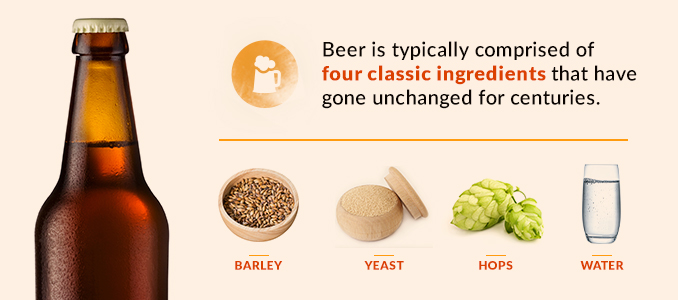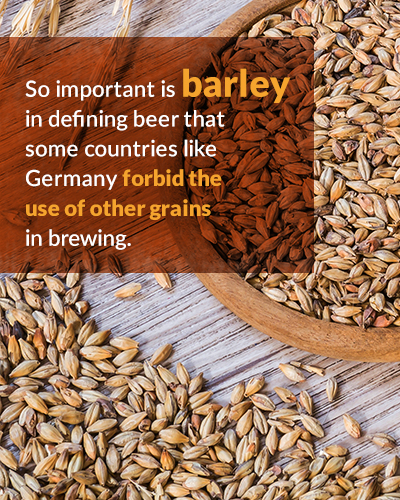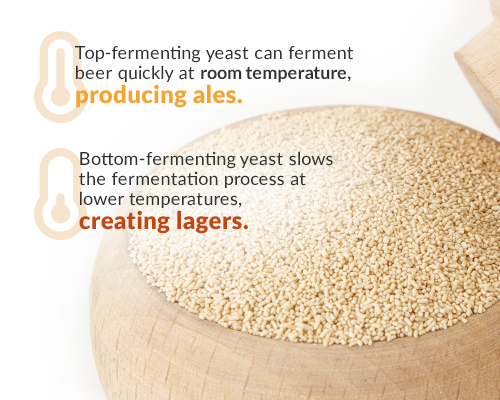Chapter 2: Nature’s Contribution — The Ingredients
Even though other types of fermentable malted grain like wheat, rice and even corn can be used in the distillation and brewing processes, beer is typically comprised of four classic ingredients that have gone unchanged for centuries.

Malted barley, yeast, hops and water are the primary components in making beer. Each offers its own contribution to the overall flavor and style of the beer being created, and can be combined with additional ingredients like fruit to complement the beverage with unique flavors.
Malting is the process of submersing the grain, or barley, into water, which allows for the germination of its seeds, followed by the sprouting of roots, which generate key enzymes in the plant. The starches in the seeds will be broken down into sugars, which were intended to allow the plant to grow, but stay intact once the germination process is halted upon drying.
When it comes to the distillation of whisky, the same basic ingredients of malted grain, water and yeast are used in the early stages, but the process of fermentation begets beer, while distillation creates the spirit, which becomes whisky once it’s aged. Even though the two alcoholic beverages might not seem similar once they are completed, the person responsible for the early stages of whisky production is also called a brewer because of their similar origin.
Ingredient lists vary, but here’s an overview of the main components used to make a great beer or whisky.
Barley
Without grain, there could be no beer, and barley is the choice grain that defines the brewing process despite the use of rice, wheat and corn in other forms of beer. Barley is so important in defining beer that some countries like Germany do not allow for the use of other grains in brewing.
Because barley is very rich in starch during germination, it provides the proper amount of sugars needed for making a great beverage once it has been malted. Malted barley contributes to the beer’s sweetness, which contrasts with the bitterness of the hops. If sugars are not fermented, they can add additional sweetness to the finished product.
Coffee and chocolate flavors, common to stouts and some porters, are achieved by using higher temperatures in the kiln during the drying process of the barley. Roasting the malt achieves the variation in flavor. Throughout the world, different species of barley are used in making beer, and each can provide their own unique flavor to the finished product. Some species of barley are more conducive for malting than others, and help increase the overall quality of the beer.
Hops
Even though German brewers didn’t add hops to the recipe until 822 AD, the addition of this aromatic plant has become indispensable in the creation of beer. Rich in resins and oils, this unique plant has long provided the bitterness that makes beer so distinctive. Hops are rich in flavors and a variety of aromas, and can provide earthy and fruity notes to the beer.
Because they provide an antibacterial effect that interacts with brewer’s yeast, hops are a great choice to counteract spoilage. The botanical properties of the hop are unlike most plants, with its closest relative being the Cannabis plant. Hops do not contain the psychoactive properties of the cannabis species.
In the modern age, hops, which are used to add flavor to the beer, are harvested and packed in a way that’s similar to coffee beans, which preserves their longevity. Brewers can add hops to the wort and boil them before fermentation, or through the process of dry hopping, they can add them after fermentation. Each process contributes different acids to the mix. The varying acids achieve the desired flavor in the finished product.
Yeast
The distinctive carbonation of beer is a direct result of the fermentation process, which is spurred by yeast, although natural carbonation can be supplemented by adding additional carbon dioxide during bottling. Yeast is a small, microscopic species of fungus that is essential in creating alcohol. Brewing yeast is a special kind of yeast that interacts with the sugars present in beer. Ales and lagers depend on two different kinds of brewer’s yeast. Top-fermenting yeast, which can ferment beer more quickly at room temperature (around 77 Fahrenheit), is conducive to the production of ales, while bottom-fermenting yeast works better in lower temperatures, slowing the fermentation process for the creation of lagers.
For distillation, a different type of yeast will be needed when making single malt whisky. The strong flavors of ales are dictated by how quickly fermentation occurs, while the softer taste of lagers is a result of a longer fermentation process. Yeast converts sugars like maltose into ethanol and carbon dioxide, which are byproducts of the metabolic process of the fungus. Esters are also created by yeast, which can contribute to the overall flavor.
Water
Water is an important ingredient in brewing beer, but the quality and mineral content of the water selected can directly influence flavor. For each pint of beer, four to six pints of water are needed for brewing.
Water quality in brewing is determined specifically by its mineral content, especially when it relates to the salts (or bicarbonate ions) present, which determine the water’s hardness. The specific type of minerals dissolved in the water can drastically affect the conversion of malt into maltose, or sugar. Water’s mineral content can change how the yeast metabolizes the acids from the sugars and hops.
Once you have the ingredients lined up, you’re ready to begin the brewing or distillation process to yield your fine beer or whisky.
Table of Contents
- Crafting Great Beer and Spirits
- Chapter 1: A Brief History of Beer — An Ancient Beverage
- Chapter 2: Nature's Contribution — The Ingredients
- Chapter 3: The Art of Brewing and Distillation
- Chapter 4: The Tools of the Trade — Vessels, Stills, and Compressors
- Chapter 5: How to Increase Energy Efficiency in Microbreweries and Distilleries
- Chapter 6: How to Save Money in Production Line with Better Bottling Practices
- Chapter 7: The Microbrewing and Craft Beer Movement
- Chapter 8: Evolution of Crafting Beer and Whiskey



